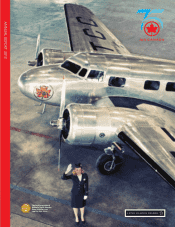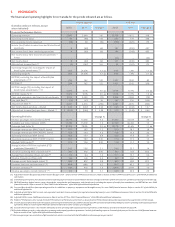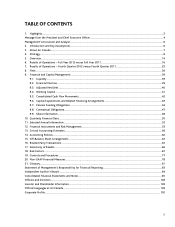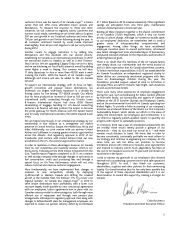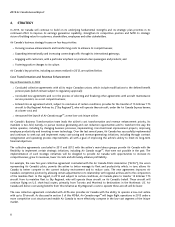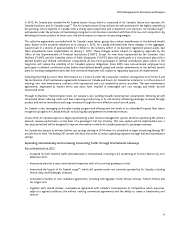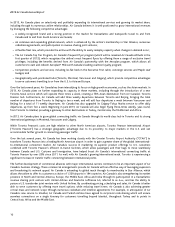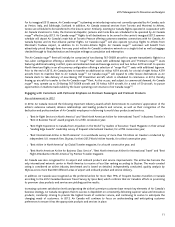Air Canada 2012 Annual Report Download - page 8
Download and view the complete annual report
Please find page 8 of the 2012 Air Canada annual report below. You can navigate through the pages in the report by either clicking on the pages listed below, or by using the keyword search tool below to find specific information within the annual report.
2012 Air Canada Annual Report
8
4. STRATEGY
In 2013, Air Canada will continue to build on its underlying fundamental strengths and its strategic plan priorities in its
continued effort to improve its earnings generation capability, strengthen its competitive position and fulfill its strategic
vision of building value for customers, shareholders, employees and other stakeholders.
Air Canada’s business strategy focuses on four key priorities:
Pursuing revenue enhancements and transforming costs to enhance its competitiveness;
Expanding internationally and increasing connecting traffic through its international gateways;
Engaging with customers, with a particular emphasis on premium class passengers and products; and
Fostering positive changes to its culture.
Air Canada’s key priorities, including successes realized in 2012, are outlined below.
Cost Transformation and Revenue Enhancement
Key achievements in 2012
Concluded collective agreements with all its major Canadian unions, which include modifications to the defined benefit
pension plans (which remain subject to regulatory approval);
Concluded new agreements and is in the process of selecting and finalizing other agreements with aircraft maintenance
service providers, on a cost competitive basis;
Entered into an agreement which, subject to conclusion of certain conditions, provides for the transfer of 15 Embraer 175
aircraft to Sky Regional Airlines Inc. (“Sky Regional”), who will operate these aircraft, under the Air Canada Express banner,
at a lower cost; and
Announced the launch of Air Canada rougeTM, a new low-cost leisure airline.
Air Canada’s Business Transformation team leads the airline’s cost transformation and revenue enhancement priority. Its
mandate is two-fold, namely, to pursue revenue generating and cost reduction opportunities and to transform the way the
airline operates, including by changing business processes, implementing cross-functional improvement projects, improving
employee productivity and investing in new technology. Over the last several years, Air Canada has successfully implemented
and continues to seek out and implement many cost-saving and revenue-generating initiatives, including through contract
renegotiation and operating process improvements, all with a goal of improving the airline’s ability to meet its long-term
financial objectives.
The collective agreements concluded in 2011 and 2012 with the airline’s main labour groups provide Air Canada with the
flexibility to implement certain strategic initiatives, including Air Canada rougeTM, that were not possible in the past. The
implementation of such strategic initiatives will be designed to provide Air Canada with opportunities to increase its
competitiveness, grow its revenues, lower its costs and ultimately enhance profitability.
For example, the new five-year collective agreement concluded with the Air Canada Pilots Association (“ACPA”), the union
representing Air Canada’s pilots, permits the airline to better manage its fleet and productivity which, in turn, allows Air
Canada to better compete in the current industry environment and to reduce costs. The new agreement improves Air
Canada’s competitive position by allowing certain adjustments to its relationship with regional airlines and to the composition
of the mainline fleet. In this regard, in 2013 and subject to certain conditions, Air Canada plans to transfer 15 Embraer 175
aircraft from its mainline fleet to Sky Regional, who will operate these aircraft on Air Canada’s behalf. These aircraft will
continue flying on U.S. short-haul routes, primarily from Toronto and Montreal to destinations in the Northeast U.S. Air
Canada will derive cost saving benefits from this initiative as Sky Regional’s costs to operate these aircraft will be lower.
The new collective agreement concluded with ACPA also provides Air Canada with the ability to operate a low-cost airline
with up to 50 aircraft. As discussed in section 3 of this MD&A, Air Canada rougeTM will begin flight operations in 2013 under a
more competitive cost structure and enable Air Canada to more effectively compete in the low-cost segment of the leisure
market.

